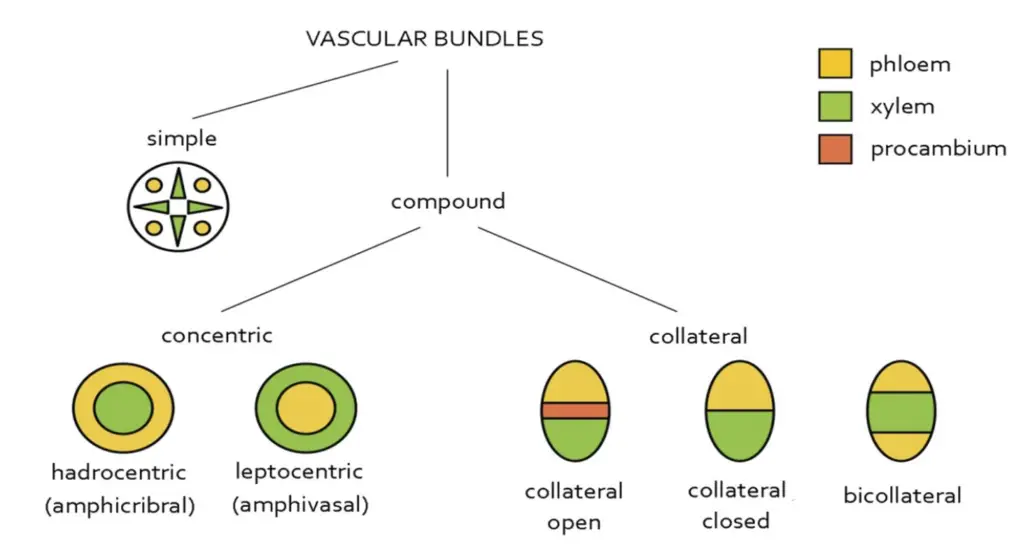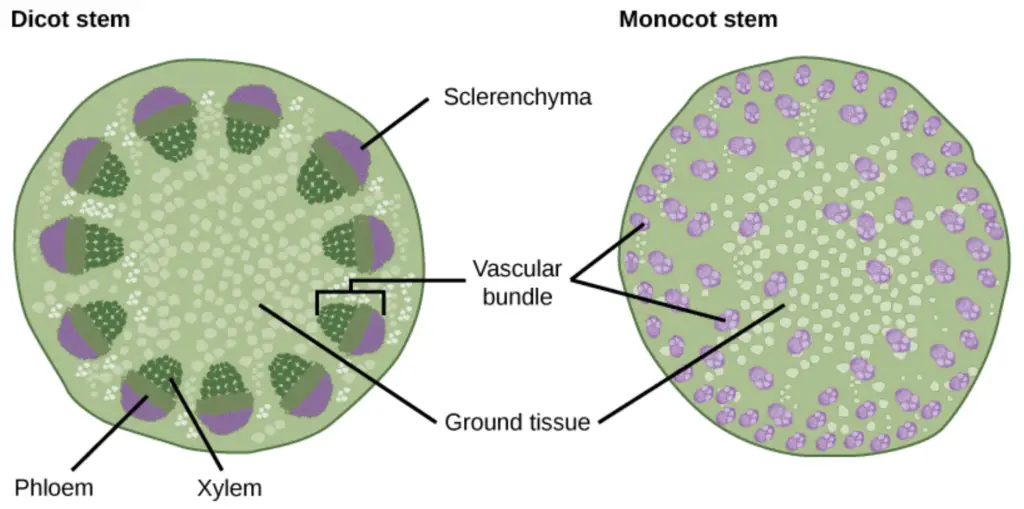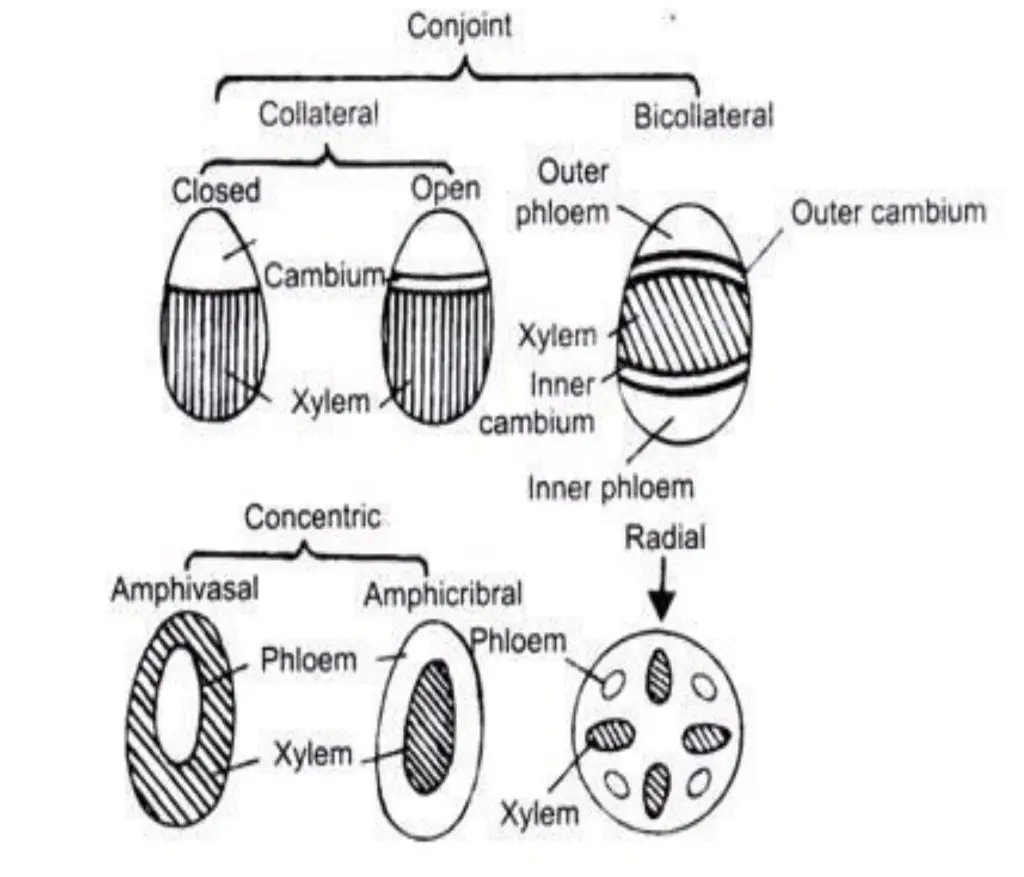What are Vascular Bundles?
- Vascular bundles are integral components of the vascular tissue system in vascular plants, facilitating the transport of essential substances such as water, minerals, and nutrients throughout the plant structure. Unlike non-vascular plants, which include certain algae and mosses, vascular plants possess this specialized tissue, enabling them to efficiently transport resources even to great heights, such as the uppermost branches of tall trees.
- The vascular tissue system comprises two primary types of conducting tissues: xylem and phloem. These tissues are organized into discrete strands known as vascular bundles. The main role of xylem is the conduction of water and dissolved minerals from the roots to other parts of the plant, a process vital for maintaining cellular functions and overall plant health. Conversely, phloem is responsible for the transport of organic nutrients, particularly the products of photosynthesis, to various plant tissues that require them for growth and development.
- Vascular bundles are typically categorized as primary bundles, forming during the early stages of plant development. They originate from the procambium, a type of meristematic tissue located at the growing tips of the plant, known as apical meristems. This organization enables vascular bundles to function as conduits for the effective movement of substances throughout the plant.
- In terms of structure, vascular bundles can vary in arrangement and composition. They may be arranged in a ring pattern in dicotyledons, or scattered throughout the stem in monocotyledons. In addition to the xylem and phloem, vascular bundles also contain supporting cells, which provide structural integrity to the plant. However, despite the presence of these supportive elements, the primary function of vascular bundles remains conduction—xylem for transporting water and minerals, and phloem for distributing food substances.
- Therefore, understanding the structure and function of vascular bundles is crucial for comprehending how vascular plants thrive in various environments. Their specialized arrangement and functioning allow plants to adapt to their surroundings, ensuring efficient resource allocation and overall growth. This vascular system not only supports the plant’s physical structure but also plays a vital role in its physiological processes.

Components of vascular bundles
Vascular bundles are fundamental structures in vascular plants, comprising two primary components: xylem and phloem. These components play essential roles in the transportation of water, minerals, and nutrients throughout the plant. Both xylem and phloem are classified as complex tissues, meaning they are made up of various cell types that contribute to their specialized functions.

- Xylem: This is the water-conducting tissue of vascular plants. It is responsible for transporting water and dissolved minerals absorbed from the soil to the aerial parts of the plant, such as stems and leaves. The xylem is composed of several key components:
- Tracheids: These are elongated cells that facilitate the conduction of water and help support the plant structure. Tracheids have thick cell walls and are crucial for water movement, especially in regions where vessels may be absent.
- Vessels: Found primarily in angiosperms, vessels are wider than tracheids and form continuous tubes that allow for more efficient water transport. Their structure enables rapid water flow through the plant.
- Xylem Fibers: These are supportive cells that provide structural strength to the xylem. Their presence reinforces the plant against mechanical stresses, ensuring stability as it grows.
- Xylem Parenchyma: This component consists of living cells that are involved in storage and lateral transport of water and nutrients. Xylem parenchyma plays a role in the overall functioning and health of the xylem tissue.
- Phloem: This is the food-conducting tissue responsible for transporting the products of photosynthesis, primarily sugars, from the leaves to other parts of the plant. The phloem also comprises multiple components:
- Sieve Cells/Sieve Tubes: These are the primary conducting cells of phloem. Sieve tubes are formed by chains of sieve tube elements that facilitate the movement of organic nutrients. They have pores in their end walls, allowing for efficient transport between cells.
- Companion Cells: Associated with sieve tube elements, companion cells are specialized parenchyma cells that help in the loading and unloading of sugars into the sieve tubes. They play a critical role in maintaining the function of the sieve elements.
- Phloem Parenchyma: Similar to xylem parenchyma, phloem parenchyma consists of living cells that contribute to storage and the lateral movement of nutrients within the phloem.
- Phloem Fibers (Bast Fibers): These fibers provide additional structural support to the phloem and help maintain the integrity of the vascular bundle. They are essential for the overall strength of the plant tissue.

Types of Vascular Bundles
The classification of vascular bundles is essential for understanding the physiological and structural complexities of plants. Vascular bundles can be categorized based on the presence or absence of cambium, which influences their capacity for secondary growth, and based on their arrangement within the plant body.

- Based on Presence or Absence of Cambium/Secondary Growth:
- Open Vascular Bundles: These bundles contain a layer of cambium situated between the xylem and phloem, which facilitates secondary growth. The term “open” indicates the potential for this secondary growth. Open vascular bundles are characteristic of dicotyledons (dicots). The cambium present in this arrangement is referred to as fascicular cambium. In this configuration, the layers are arranged as follows: phloem, cambium, phloem, xylem, and xylem.
- Closed Vascular Bundles: In contrast, closed vascular bundles lack cambium, thus prohibiting secondary growth, hence the term “closed.” These bundles are typically found in monocotyledons (monocots). The absence of fascicular cambium signifies that these bundles do not contribute to secondary growth.
- Based on Arrangement in the Plant Body:
- Radial Vascular Bundles: This type of vascular bundle features xylem and phloem arranged separately, typically along different radii. While they do not technically qualify as bundles, this arrangement is primarily observed in the roots of both monocots and dicots.
- Conjoint Vascular Bundles: In contrast to radial arrangements, conjoint vascular bundles display xylem and phloem together along the same radius. These bundles are prevalent in stems and leaves and can be further classified into three subtypes:
- Collateral Vascular Bundles: In this subtype, xylem is positioned towards the interior (adaxial side), while phloem is located towards the exterior (abaxial side). Collateral vascular bundles are the most common type, and their classification as open or closed depends on the presence or absence of cambium.
- Bi-collateral Vascular Bundles: This type consists of phloem in two distinct groups: one located outside the xylem and the other inside it. This arrangement places the xylem between two strands of phloem. Bi-collateral vascular bundles are typically observed in certain angiosperm families, such as Cucurbitaceae (for example, Cephalandra and Cucurbita).
- Concentric Vascular Bundles: Characterized by one type of vascular element completely encircling another, concentric vascular bundles can either have phloem surrounding xylem or vice versa. This category is divided into two types:
- Amphicribral (Hadrocentric) Vascular Bundles: In this arrangement, xylem is centrally located and surrounded by a ring of phloem. Such configurations are observed in the meristeles of ferns, as well as in the small vascular traces of flowers, fruits, and ovules.
- Amphivasal (Leptocentric) Vascular Bundles: Here, the phloem is centrally located, enveloped by a ring of xylem. Examples include the stems of Dracaena, as well as species like Rumex and Begonia.
Functions of Vascular Bundles
Vascular bundles play a critical role in the functioning of vascular plants, serving multiple essential functions that facilitate their growth and survival. Below are the key functions of vascular bundles:
- Transport of Water and Minerals: The xylem, a primary component of vascular bundles, is responsible for the conduction of water and dissolved minerals from the roots to the aerial parts of the plant. This upward movement is vital for photosynthesis, as it provides the necessary hydration and nutrients for cellular processes.
- Transport of Food: The phloem, the other main component of vascular bundles, is primarily involved in the transport of organic nutrients, particularly the products of photosynthesis, from the leaves to other parts of the plant. This movement ensures that all tissues receive the energy they require for growth, development, and metabolic activities.
- Support and Structural Integrity: Vascular bundles contribute to the mechanical support of the plant. The xylem consists of lignified cells that provide rigidity and strength, helping the plant maintain its structure and resist external forces such as wind. This structural support is crucial, especially in tall plants and trees.
- Facilitation of Secondary Growth: In open vascular bundles, the presence of cambium allows for secondary growth, which leads to an increase in the thickness of stems and roots. This growth is essential for plants to achieve greater height and stability, as well as to produce additional vascular tissue needed for efficient transport.
- Storage of Nutrients: Vascular bundles can also contain parenchyma cells, which serve as storage sites for starch, proteins, and other nutrients. This stored energy can be mobilized when needed, particularly during periods of growth or when photosynthesis is not occurring (e.g., at night or during winter).
- Regulation of Water Loss: The arrangement of vascular bundles in leaves, particularly near stomata, helps in regulating water loss through transpiration. Efficient transport of water helps maintain turgor pressure, allowing for optimal leaf structure and function, while also influencing gas exchange.
- Response to Environmental Stimuli: Vascular bundles can adapt to environmental changes, such as light availability and water stress. This responsiveness allows plants to optimize their growth and resource allocation under varying conditions.
- https://easybiologyclass.com/vascular-bundles-structure-composition-classification-vascular-bundles-in-plants-plant-anatomy/
- http://courseware.cutm.ac.in/wp-content/uploads/2020/06/The-vascular-tissue-systems.pdf
- https://www.plantscience4u.com/2014/04/types-of-vascular-bundles-in-plants.html
- https://bnmv.ac.in/images/uploads/Vascular%20Bundles.pdf
- Text Highlighting: Select any text in the post content to highlight it
- Text Annotation: Select text and add comments with annotations
- Comment Management: Edit or delete your own comments
- Highlight Management: Remove your own highlights
How to use: Simply select any text in the post content above, and you'll see annotation options. Login here or create an account to get started.